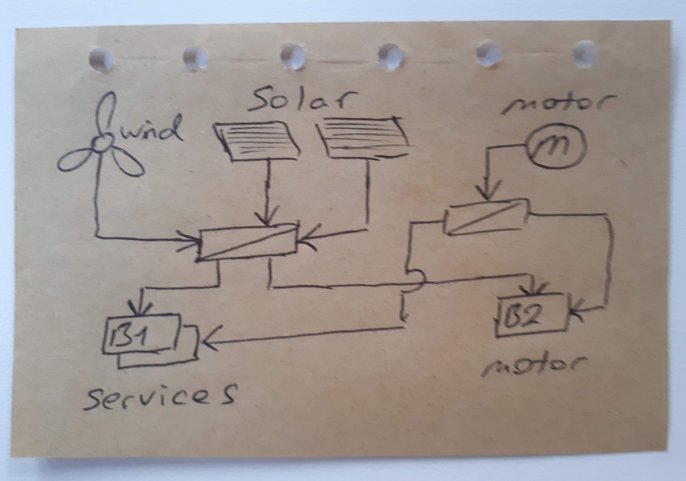Obviously on a sailing boat you don’t have a connection to the grid. Almost as obvious is that you have devices that use electricity. The result is that you have to generate your own power and use less than you produce.
The diesel motor needs electricity to turn the starter and also generates electricity when it is running. It first charges its own battery (B2 in the diagram) and then uses anything left over to charge the services battery bank (B1). This means that the service batteries rarely get a good charge from the motor especially as we try to avoid running it and prefer to be a sail boat. Most sailing days we mange less than an hour of “motor boating” and at anchor it is always off.

We have a wind generator mounted on the stern and two 80 Watt solar panels mounted one on each side of the cockpit. All this produces a long term average of 2A day and night – so 48Ah a day. The solar produces more than the wind but the wind often blows when there is less sunlight.
So on the incoming side of the batterys we have 2A. And on the outgoing side we have:
- Fridge (uses 6A)
- Heating (about 5A)
- Navigation equipment (2.5A but loads more with radar on)
- VHF radio (0.5A)
- PC, 2 tablets and 2 phones
- Power tools
- Lighting
- Various pumps.
The trick is to minimize the use of any and all devices and charge them when there is power available.
The fridge cools best at night (when the ambient temperature is lower) so we cool that for about 6 hours a night and use up about ¾ of what we produce. The heating has been off since Scotland. The navigation equipment only gets switched on when absolutely necessary and the radio is on when we are at sea. The PC is rarely unpacked.
Tablets, phones and tools are charged up (as far as possible) when the system is fully charged. We have USB and power tool power packs to “save” extra power.
The tablets are the real “workhorses”. They have our charts on them, navigation software installed and the anchor watch (to check if we are drifting at anchor). Together with Google, we use them to blog, organise our photos, read books and communicate. They do all this while using next to no electricity. The phones are our “communication centers” and just as energy efficient.
All the lights are LED and the pumps very rarely run.
Right now the system is working and we don’t miss the electricity bill.


Less is a lot more, Ah?
Hi neil, yes, exactly less is more!
I recently bought a Rutland 1200 wind generator, it makes at 10 knots wind 2,9A. That’s great
many greetings
Andi / SV ORIZON
Hello Andi. Last night our generator was making 16 to 18 amps.
But there was a 25 knot wind blowing. Proves once again the anchor works 🙂
Hi Neill, cool! At 25 knots you have at anchor at least no wave from the side … 🙂 The Rutland is to deliver 400W at 25 knots, I’m curious if this is really the case.
We are from 9 January to 13 March on La Palma, then in Port Louis San Du Rhone on the ship.